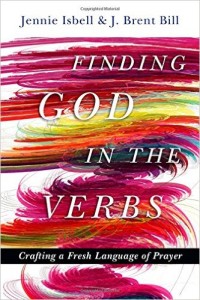Finding God in the Verbs: Crafting a Fresh Language of Prayer
Reviewed by Steve Chase
November 1, 2015
 By Jennie Isbell and J. Brent Bill. InterVarsity Press, 2015. 186 pages. $16/paperback; $12.99 eBook.
By Jennie Isbell and J. Brent Bill. InterVarsity Press, 2015. 186 pages. $16/paperback; $12.99 eBook.
Buy on FJ Amazon Store
When I started my job as director of education at Pendle Hill, an outgoing staff member handed me a copy of the 1929 prospectus for creating this 85-year-old Quaker education center. In that document, the founders of Pendle Hill said they wanted to create “a Quaker school for prophets.” For me, learning to be prophetic involves at least three dimensions of spiritual life: (1) directly experiencing divine love, presence, and guidance; (2) understanding, serving, and challenging our faith traditions; and (3) working with our neighbors to create a beloved community of justice, sustainability, and equality.
Is it any wonder then that I jumped at the chance to review Jennie Isbell’s and Brent Bill’s new book Finding God in the Verbs: Crafting a Fresh Language of Prayer? This book first emerged out of Isbell’s well-received prayer workshops among Friends and was then enlarged and distilled over many conversations between her and Bill, an appreciative participant in one of Isbell’s workshops and a Quaker author and minister in his own right.
While these authors sometimes conflate the terms “fresh” and “new” in the text, they do make it clear that what they want to cultivate in each searching, spiritual heart is not some brand new technique of prayer that is better than all prayer forms used in the past. They are simply talking about moving from rote, conventional, and stale forms of prayer into fresh, deep, more personal and authentic intimacy with God—something that soulful mystics and prophets have done for thousands of years in their prayers.
The authors start from a powerful insight into our modern spiritual lives. Who among us has not “found ourselves slipping into patterns of oft-repeated prayers that weren’t up to the task of spiritually nourishing communication with God”? Who among us, if we bother to pray at all, has not settled, at least for a time, for “snack-bar, microwave-meal and TV-dinner equivalents of prayer instead of homegrown, home-cooked, made-in-love sort of prayers that we [have] been fed by in innumerable ways”?
In nine chapters, 35 exercises, and a few appendices, this lovely, honest, and searching book helps us move beyond our bad habits and overcome our resistances to powerful and meaningful engagement with Spirit through an intimate, stripped-down, and empowering prayer language. While I would have urged changing the order of some of the chapters and would have given the book and a few chapters more accurate titles, the power of this book is not to be denied.
The book deepened my own understanding of my faith tradition as a friend and follower of that upstart Jewish prophet from Nazareth who so movingly revealed and incarnated the way and wisdom of God back in first-century Palestine. It also deepened my sense of the possibilities available in the spiritual practice of prayer that prompted the early disciples of Jesus to acknowledge their limited understandings of what prayer could be and say “Lord, teach us to pray.”
To their credit, Isbell and Bill faithfully incarnate the Spirit that guided Jesus and so many other prophets and mystics throughout time. Like Jesus, they do not teach us how to pray in a didactic, rule-based way. Instead, they model intimate, personal, and soulful prayers, and tell prayer stories as parables. They also pose a series of questions wherein your personal answers matter and might differ from the people around you.
In my experience, moving beyond just reading the book and actually engaging in the exercises helps move the reader even deeper into personal discovery. Through these exercises, each of us can deconstruct what our own actual prayer life is like, reconstruct what it could be, and experiment with a more personally powerful language of prayer. In just one quick reading of the book, and doing some of the exercises, I rekindled a more powerful language of prayer that let go of what, for me, proved to be needless and inhibiting habits and phrases, but also held on to and deepened more heart-felt ways of conversing with God in both individual prayer and common worship.
It is hard to underestimate the gift that this imperfect but powerful book offers. It gives Friends, and other people of faith, a short, poignant, down-to-earth, and often funny look at how we might best converse with the Divine and experience moments of profound grace while enhancing how we incarnate the ways and wisdom of God in our own personal, professional, and public lives. It is a 186-page “Quaker school for prophets” held between two covers, and it helped me say yes, wow, please, and thank you to the divine source and ground of all our being.
I look forward to going through the book and exercises again, even more slowly in the coming months.



Comments on Friendsjournal.org may be used in the Forum of the print magazine and may be edited for length and clarity.